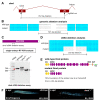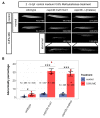Loss of calpain3b in Zebrafish, a Model of Limb-Girdle Muscular Dystrophy, Increases Susceptibility to Muscle Defects Due to Elevated Muscle Activity
- PMID: 36833417
- PMCID: PMC9957097
- DOI: 10.3390/genes14020492
Loss of calpain3b in Zebrafish, a Model of Limb-Girdle Muscular Dystrophy, Increases Susceptibility to Muscle Defects Due to Elevated Muscle Activity
Abstract
Limb-Girdle Muscular Dystrophy Type R1 (LGMDR1; formerly LGMD2A), characterized by progressive hip and shoulder muscle weakness, is caused by mutations in CAPN3. In zebrafish, capn3b mediates Def-dependent degradation of p53 in the liver and intestines. We show that capn3b is expressed in the muscle. To model LGMDR1 in zebrafish, we generated three deletion mutants in capn3b and a positive-control dmd mutant (Duchenne muscular dystrophy). Two partial deletion mutants showed transcript-level reduction, whereas the RNA-less mutant lacked capn3b mRNA. All capn3b homozygous mutants were developmentally-normal adult-viable animals. Mutants in dmd were homozygous-lethal. Bathing wild-type and capn3b mutants in 0.8% methylcellulose (MC) for 3 days beginning 2 days post-fertilization resulted in significantly pronounced (20-30%) birefringence-detectable muscle abnormalities in capn3b mutant embryos. Evans Blue staining for sarcolemma integrity loss was strongly positive in dmd homozygotes, negative in wild-type embryos, and negative in MC-treated capn3b mutants, suggesting membrane instability is not a primary muscle pathology determinant. Increased birefringence-detected muscle abnormalities in capn3b mutants compared to wild-type animals were observed following induced hypertonia by exposure to cholinesterase inhibitor, azinphos-methyl, reinforcing the MC results. These mutant fish represent a novel tractable model for studying the mechanisms underlying muscle repair and remodeling, and as a preclinical tool for whole-animal therapeutics and behavioral screening in LGMDR1.
Keywords: Duchenne muscular dystrophy; birefringence; calpain 3; cholinesterase inhibitor; disease model; limb-girdle muscle dystrophy; methylcellulose; muscle; zebrafish.
Conflict of interest statement
S.V.P. and K.B. declare no conflict of interest. J.N.B. is a member of the Scientific Advisory Board of Oxford Algorithmics. L.C., A.C.S., K.N. and E.P.H. disclosed their potential conflicts of interest in the appropriate form.
Figures






Similar articles
-
Capn3b-deficient zebrafish model reveals a key role of autoimmune response in LGMDR1.J Genet Genomics. 2024 Dec;51(12):1375-1388. doi: 10.1016/j.jgg.2024.09.011. Epub 2024 Sep 28. J Genet Genomics. 2024. PMID: 39349278
-
Calcium Mechanisms in Limb-Girdle Muscular Dystrophy with CAPN3 Mutations.Int J Mol Sci. 2019 Sep 13;20(18):4548. doi: 10.3390/ijms20184548. Int J Mol Sci. 2019. PMID: 31540302 Free PMC article. Review.
-
Mutational Spectrum of CAPN3 with Genotype-Phenotype Correlations in Limb Girdle Muscular Dystrophy Type 2A/R1 (LGMD2A/LGMDR1) Patients in India.J Neuromuscul Dis. 2021;8(1):125-136. doi: 10.3233/JND-200547. J Neuromuscul Dis. 2021. PMID: 33337384
-
Missense mutation of c.635 T > C in CAPN3 impairs muscle injury repair in a Limb-Girdel Muscular Dystropy Model.Clin Genet. 2023 Jun;103(6):663-671. doi: 10.1111/cge.14330. Epub 2023 Mar 31. Clin Genet. 2023. PMID: 36999564
-
Diagnosis and cell-based therapy for Duchenne muscular dystrophy in humans, mice, and zebrafish.J Hum Genet. 2006;51(5):397-406. doi: 10.1007/s10038-006-0374-9. Epub 2006 Apr 1. J Hum Genet. 2006. PMID: 16583129 Free PMC article. Review.
Cited by
-
Standardization of zebrafish drug testing parameters for muscle diseases.Dis Model Mech. 2024 Jan 1;17(1):dmm050339. doi: 10.1242/dmm.050339. Epub 2024 Jan 18. Dis Model Mech. 2024. PMID: 38235578 Free PMC article.
-
Cross-generational plasticity in Atlantic silversides (Menidia menidia) under the combined effects of hypoxia and acidification.J Exp Biol. 2025 Aug 1;228(15):jeb249726. doi: 10.1242/jeb.249726. Epub 2025 Jul 25. J Exp Biol. 2025. PMID: 40626633 Free PMC article.
-
Age, muscle, and gender specific characterization of muscle degeneration in a mouse model of calpainopathy.Sci Rep. 2025 Sep 12;15(1):32507. doi: 10.1038/s41598-025-17742-3. Sci Rep. 2025. PMID: 40940393 Free PMC article.
References
-
- Ono Y., Shimada H., Sorimach H., Richard I., Saido T.C., Beckmann J.S., Ishiura S., Suzuki K. Functional Defects of a Muscle-Specific Calpain, P94, Caused by Mutations Associated with Limb-Girdle Muscular Dystrophy Type 2A. J. Biol. Chem. 1998;273:17073–17078. doi: 10.1074/jbc.273.27.17073. - DOI - PubMed
Publication types
MeSH terms
Supplementary concepts
LinkOut - more resources
Full Text Sources
Molecular Biology Databases
Research Materials
Miscellaneous

